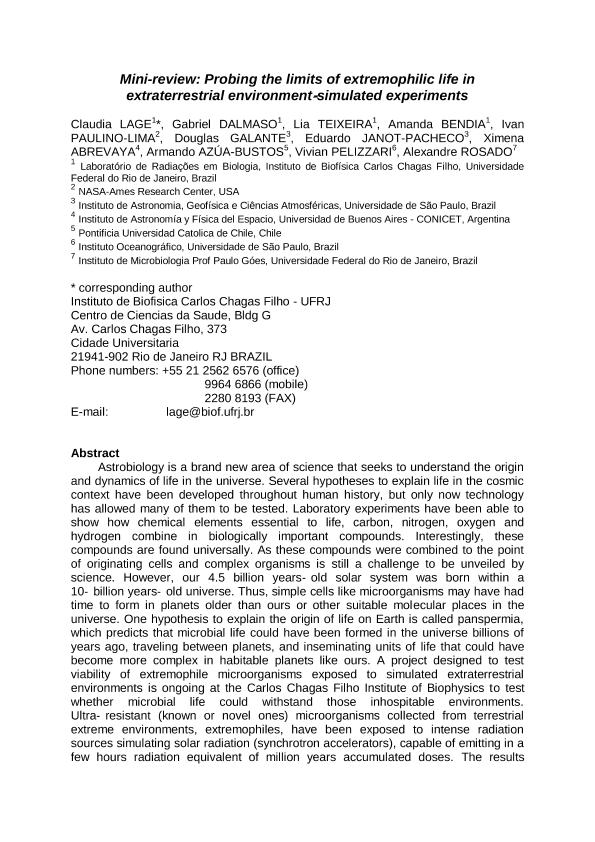Artículo
Probing the limits of extremophilic life in extraterrestrial environment-simulated experiments
Lage, Claudia; Dalmaso, Gabriel; Texeira, Lia; Bendia, Amanda; Paulino Lima, Ivan; Galante, Douglas; Janot Pacheco, Eduardo; Abrevaya, Ximena Celeste ; Azúa Bustos, Armando; Pellizzari, Vivian; Rosado, Alexandre
; Azúa Bustos, Armando; Pellizzari, Vivian; Rosado, Alexandre
 ; Azúa Bustos, Armando; Pellizzari, Vivian; Rosado, Alexandre
; Azúa Bustos, Armando; Pellizzari, Vivian; Rosado, Alexandre
Fecha de publicación:
08/2012
Editorial:
Cambridge University Press
Revista:
International Journal Of Astrobiology
ISSN:
1473-5504
Idioma:
Inglés
Tipo de recurso:
Artículo publicado
Clasificación temática:
Resumen
Astrobiology is a relatively recent scientific field that seeks to understand the origin and dynamics of life in the Universe. Several hypotheses have been proposed to explain life in the cosmic context throughout human history, but only now, technology has allowed many of them to be tested. Laboratory experiments have been able to show how chemical elements essential to life, such as carbon, nitrogen, oxygen and hydrogen combine in biologically important compounds. Interestingly, these compounds are ubiquitous. How these compounds were combined to the point of originating cells and complex organisms is still to be unveiled by science. However, our 4.5 billion years old Solar system appeared in a 10 billion years old Universe. Thus, simple cells such as micro-organisms may have had time to form in planets older than ours or in other suitable places in the universe. One hypothesis related to the appearance of life on Earth is called panspermia, which predicts that microbial life could have been formed in the Universe billions of years ago, travelling between planets, and inseminating units of life that could have become more complex in habitable planets such as Earth. A project designed to test the viability of extremophile micro-organisms exposed to simulated extraterrestrial environments is in progress at the Carlos Chagas Filho Institute of Biophysics (UFRJ, Brazil) to test whether microbial life could withstand inhospitable environments. Radiation-resistant (known or novel ones) micro-organisms collected from extreme terrestrial environments have been exposed (at synchrotron accelerators) to intense radiation sources simulating Solar radiation, capable of emitting radiation in a few hours equivalent to many years of accumulated doses. The results obtained in these experiments reveal an interesting possibility of the existence of microbial life beyond Earth.
Palabras clave:
Panspermia
,
Extremophiles
,
Uv
,
Cosmic Dust
Archivos asociados
Licencia
Identificadores
Colecciones
Articulos(IAFE)
Articulos de INST.DE ASTRONOMIA Y FISICA DEL ESPACIO(I)
Articulos de INST.DE ASTRONOMIA Y FISICA DEL ESPACIO(I)
Citación
Lage, Claudia; Dalmaso, Gabriel; Texeira, Lia; Bendia, Amanda; Paulino Lima, Ivan; et al.; Probing the limits of extremophilic life in extraterrestrial environment-simulated experiments; Cambridge University Press; International Journal Of Astrobiology; 11; 4; 8-2012; 1-11
Compartir
Altmétricas



